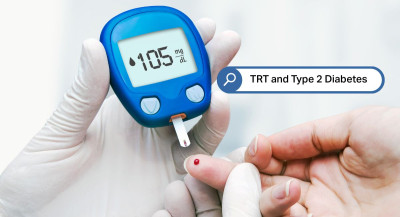TRT For Men Over 60: Is It Ever Too Late To Benefit?


As men in Canada reach their 60s and beyond, it’s normal for testosterone levels to decline, often leading to fatigue, lower libido, reduced muscle mass, and mood changes.

While some assume it’s too late to do anything about it, that’s not always true. In fact, testosterone replacement therapy (TRT) in Canada is increasingly being considered for men over 60 who experience symptoms of low T and want to improve their quality of life.
The question isn’t just about age, it’s about whether the benefits outweigh the risks for each individual.
This article explores how TRT may still offer value later in life, what the science says, and how to make informed, medically guided decisions.
Topics covered in this article:
- What Happens to Testosterone After Age 60
- What the Research Says About TRT in Older Men
- otential Benefits for Men Over 60
- Risks and Limitations Specific to Age
- How to Decide If TRT Is Right for You at 60+
- What to Expect: Dosage, Monitoring, and Lifestyle
- FAQs: Common Questions for Men Over 60 Considering TRT
- Conclusion: Age Doesn’t Have to Be a Barrier, With Smart Care
- References
What Happens to Testosterone After Age 60
As men pass age 60, it is normal for testosterone levels to decline further, and many begin to notice symptoms or health challenges connected to that drop. Research shows decline is gradual but meaningful, and varies widely between individuals.

Key changes and common challenges include:
- Natural hormone decline: Testosterone levels typically fall about 1% per year after a certain age (often cited as after age 40). By age 60‑70, many men will have noticeable drops in both total and free testosterone levels.
- Symptoms intensify: Men over 60 often report more severe fatigue, reduced libido, weaker erections, and less spontaneous sexual activity. These are some of the more visible signs of declining testosterone.
- Loss of muscle mass and strength: Age‑related sarcopenia is common, and testosterone decline contributes to muscles repairing more slowly, making it harder to maintain strength, making regular physical activity harder.
- Increase in fat, especially visceral fat: Along with declining hormone levels, many men accumulate more abdominal fat, which further contributes to metabolic risk (insulin resistance, cardiovascular risk).
- Mood, cognition, and energy fluctuations: Alongside physical changes, men may experience more mood swings, feelings of low motivation, difficulty concentrating or memory lapses, and general decline in wellbeing. Some of these overlap with other age‑related conditions.
Because many symptoms of low testosterone overlap with normal aging or other health issues, it can be tricky to tell what is just aging and what may respond to TRT. That is why careful evaluation is essential.
What the Research Says About TRT in Older Men
Studies in older men (age 60+) show that testosterone replacement therapy (TRT) can offer measurable benefits, though the results vary depending on health status, dosage, and duration. Key findings from recent trials and analyses include:
- A review published in Maturitas (2023) reported that TRT in men aged 65 or older can improve sexual desire, erectile function, and orgasmic satisfaction, especially in those with documented low testosterone and moderate symptoms.
- An updated meta‑analysis of 28 randomized controlled trials (RCTs) involving over 3,400 hypogonadal men found that TRT significantly improved erectile function (IIEF score) without worsening prostate‑specific antigen (PSA) levels, urinary symptoms, or prostate volume. The improvements were seen across different methods of administration (injections, gels, patches).
- The “T4DM” trial followed men aged 50–74 at high risk, including some over 60, and found that TRT plus lifestyle intervention reduced fat mass, increased muscle mass, improved glucose control, and reduced the risk of developing full Type 2 diabetes compared with lifestyle intervention alone.
- A systematic position statement (EMAS 2023) suggests that TRT may be offered to men aged 65+ who have clinically low testosterone, provided they have symptoms and that benefits and risks are carefully weighed.
Limitations and Ongoing Questions
- Many benefits reported are modest and may take several months to appear, especially for outcomes like bone density, muscle strength, or metabolic changes.
- Older men often have more comorbid conditions (e.g. cardiovascular disease, prostate issues) which can influence safety and response.
- Long‑term safety data (beyond 3 years) are still limited, so ongoing monitoring is essential.
Read more: TRT And Prostate Health
otential Benefits for Men Over 60
For men over 60 with clinically low testosterone, testosterone replacement therapy (TRT) may offer a range of potential health improvements, particularly when symptoms like fatigue, reduced libido, or muscle loss are affecting quality of life. According to clinical research, the most common benefits include:

- Stronger bones: TRT can help increase bone mineral density, especially in the lumbar spine and hip. This is particularly important for older men at risk of osteoporosis or fractures.
- Increased muscle mass and strength: Testosterone plays a key role in preserving lean muscle. Several trials have shown improvements in muscle mass and strength, especially in the legs, after several months of therapy.
- Enhanced sexual function: Many men report improvements in libido, morning erections, and overall sexual satisfaction when testosterone levels are restored to normal.
- Better mood and energy: Some older men experience reduced fatigue, improved mood, and better mental focus with TRT, although these benefits can vary from person to person.
- Improved quality of life: When symptoms are significant, TRT may support better physical functioning and overall wellbeing, making it easier to stay active and socially engaged.
These benefits are most likely to appear when testosterone levels are clearly low and treatment is carefully managed by a healthcare provider. It is not recommended as an anti-ageing therapy for men with normal testosterone.
Risks and Limitations Specific to Age
While testosterone replacement therapy (TRT) may offer benefits for men over 60, it also comes with age-specific risks that require careful evaluation and ongoing medical supervision. Some of the most important considerations include:
- Cardiovascular health: Older men with existing heart disease or risk factors should be closely monitored during TRT. While newer research suggests TRT may be safe for many, the evidence is still mixed, and treatment should be tailored to the individual.
- Prostate monitoring: TRT does not appear to cause prostate cancer, but it can stimulate the prostate. This means men with a history of prostate issues or elevated PSA levels should be monitored regularly.
- Polycythemia: TRT can increase red blood cell count, which may raise the risk of blood clots or stroke. Older adults are more likely to develop this condition, so periodic blood tests are essential.
- Sleep apnea: Testosterone can sometimes worsen or unmask obstructive sleep apnea, especially in older men who are overweight or already have breathing issues during sleep.
These risks do not mean TRT is unsafe for all older men. However, they highlight the importance of thorough screening, regular lab tests, and working with a provider who understands how to manage testosterone therapy safely in this age group.
How to Decide If TRT Is Right for You at 60+
Deciding whether to start testosterone replacement therapy (TRT) after 60 depends on more than just age. It requires a full assessment of symptoms, hormone levels, and overall health. In Canada, men considering testosterone replacement therapy (TRT) should go through a structured evaluation that includes:
- Symptom review: Fatigue, low libido, mood changes, reduced muscle mass, and poor concentration are common signs of low testosterone—but they can also stem from other conditions.
- Blood testing: A diagnosis of low testosterone requires at least two separate early morning blood tests confirming below-normal levels of total and, sometimes, free testosterone.
- Medical history: Doctors will consider other health issues such as diabetes, cardiovascular disease, prostate concerns, and sleep apnea to determine if TRT is safe and appropriate.
- Treatment goals: TRT may be more beneficial when symptoms are clearly linked to low testosterone and the goal is to improve energy, strength, libido, or quality of life—not simply to “reverse aging.”
TRT is not a one-size-fits-all solution. For men over 60, the decision should be personalized and guided by a healthcare provider who can weigh the risks and benefits based on your full health profile.

What to Expect: Dosage, Monitoring, and Lifestyle
For men over 60, testosterone replacement therapy (TRT) in Canada is usually started cautiously, with lower doses and closer monitoring to reduce risks and track effectiveness. Here’s what to expect:
- Starting low: Doctors often begin with a conservative TRT dosage, especially for older patients, and gradually adjust based on lab results and how symptoms respond.
- Regular monitoring: Ongoing blood work is essential to track testosterone levels, red blood cell counts (to prevent polycythemia), PSA levels (for prostate health), and lipid and liver profiles.
- Lifestyle support: TRT works best when combined with healthy habits. Doctors typically encourage:
- Regular exercise, particularly resistance training
- A balanced diet to support metabolic and cardiovascular health
- Weight management, especially if abdominal fat is a concern
- Good sleep hygiene, as sleep apnea can be both a cause and consequence of low T
Medical providers will also reassess symptoms and side effects periodically to make sure the treatment is safe and worthwhile.
FAQs: Common Questions for Men Over 60 Considering TRT
No. Many men in their 60s and beyond can benefit from TRT if they have confirmed low testosterone and related symptoms. Age alone is not a disqualifier, but medical evaluation is essential.
The main concerns include cardiovascular issues, prostate monitoring (especially PSA levels), increased red blood cell count, and the potential impact on sleep apnea. These risks can be managed with regular monitoring.
Many men report improved vitality, mood, sexual desire, and even cognitive sharpness. Results vary, and improvements may take a few weeks to months, depending on your overall health.
Some men notice improvements in energy and mood within a few weeks. Benefits related to muscle mass, libido, and body composition often take a few months. Consistency and follow-up care matter.
TRT is often a long-term therapy, especially if symptoms return when treatment stops. However, ongoing evaluations with your doctor in Canada can help you decide what’s best based on your goals and health status.
Conclusion: Age Doesn’t Have to Be a Barrier, With Smart Care
Testosterone replacement therapy (TRT) in Canada is not just for younger men. For those over 60, it can be a safe and effective option when prescribed with care. Age brings its own considerations, but it doesn’t mean giving up on energy, strength, or sexual health.
If you’re experiencing symptoms of low testosterone—fatigue, low libido, reduced muscle mass, or mood changes—getting tested is the first step. With the right monitoring, dosage, and medical support, TRT can help you maintain vitality and quality of life well into your later years.
Always talk to a licensed healthcare provider before starting treatment. With smart care, age doesn’t have to stand in your way.
References
UPGUYS has strict sourcing guidelines to ensure our content is accurate and current. We rely on peer-reviewed studies, academic research institutions, and medical associations. We strive to use primary sources and refrain from using tertiary references.- Predicting low testosterone in aging men: a systematic review, PubMed,
https://pubmed.ncbi.nlm.nih.gov/27325129/ - Low Testosterone (Male Hypogonadism), Cleveland Clinic,
https://my.clevelandclinic.org/health/diseases/15603-low-testosterone-male-hypogonadism - Canadian Urological Association guideline on testosterone deficiency in men: Evidence-based Q&A, PubMed,
https://pubmed.ncbi.nlm.nih.gov/33661092/ - The Role of Testosterone in the Elderly: What Do We Know?, PubMed,
https://pubmed.ncbi.nlm.nih.gov/35408895/ - EMAS position statement: Testosterone replacement therapy in older men, Maturitas,
https://www.maturitas.org/article/S0378-5122(23)00460-7/fulltext - An updated systematic review and meta-analysis of the effects of testosterone replacement therapy on erectile function and prostate, PubMed,
https://pubmed.ncbi.nlm.nih.gov/38344665/ - Testosterone Therapy in Older Men: Present and Future Considerations, Springer Nature Link,
https://link.springer.com/article/10.1007/s40266-025-01209-1
This article is written for informational purposes only and does not constitute medical advice. The information provided in the articles cannot and should not replace advice from a healthcare professional. Talk to your healthcare provider about any physical or mental health concerns or the risks and benefits of any treatment or medication.





